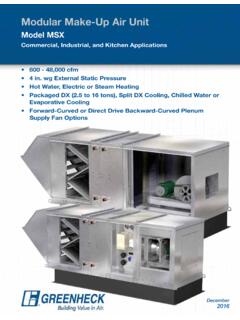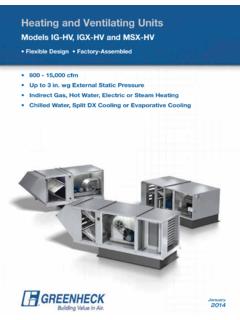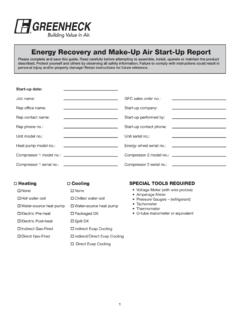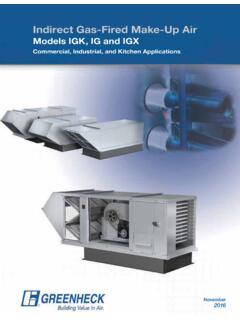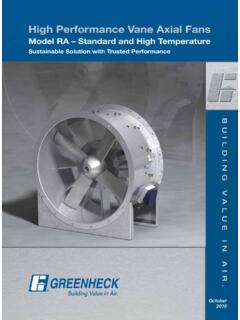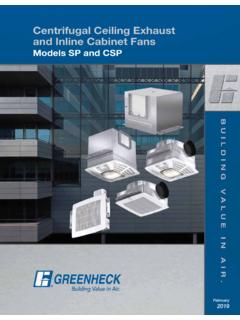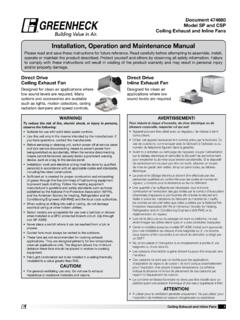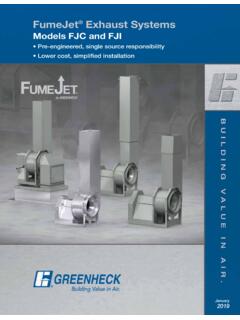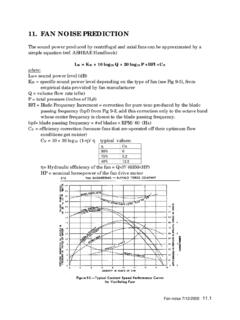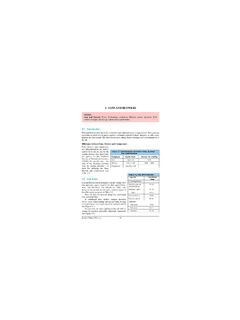Transcription of USF Centrifugal Fan Performance Supplement
1 USF Centrifugal Fan Performance Supplement Engineering Information Air Performance Sound Performance . April 2016. Table of Contents Engineering Data Motor Starting Torque .. 3. V-Belt Drives .. 3. Wheel Moments of Inertia .. 3. Fan RPM Limitations .. 3. Effects of Air Density .. 4. Effect of Installation on Performance .. 5. Sound Performance Testing ..6-7. Sample Fan Selection ..8-9. Air and Sound Performance Data Tabulated Air & Sound Performance ..11-59. Greenheck Fan Corporation certifies that the model USF-BI and USF-AF shown MODEL AMCA SIZES. herein are licensed to bear the AMCA seal. USF-BI 200 AMCA Air 6 - 10.
2 The ratings shown are based on tests and procedures performed in accordance with USF-BI 200 AMCA Sound and Air 12 - 22. AMCA Publication 211 and comply with the requirements of the AMCA Certified Ratings USF-BI 300 AMCA Air 6 - 10. Program. USF-BI 300 AMCA Sound and Air 12 - 24. Greenheck Fan Corporation certifies that the USF-BI 300 AMCA Air 27 - 49. model USF-BI and USF-AF shown herein are licensed to bear the AMCA Seal. The ratings USF-AF 400 AMCA Sound and Air 18 - 49. shown are based on tests and procedures USF-BI 400 AMCA Sound and Air All sizes (7 - 49). performed in accordance with AMCA. Publication 211 and AMCA Publication 311 and comply with the requirements of the AMCA.
3 Certified Ratings Program. Computer Aided Product Selection Program CAPS. All Greenheck products are supported by the industry's best product literature, electronic media, and Computer Aided Product Selection program, CAPS. Online, you can also find electronic copies of our product literature as well as storage, installation and maintenance information in our Installation and Operation Manuals. And, of course, you can always count on the personal service and expertise of our national and international representative organization. To locate your nearest Greenheck representative call 715-359-6171 or visit our website at To-Scale Drawings and Fan Specifications To-scale CAD drawings along with detailed Centrifugal specifications can be found online at or within our Computer Aided Product Selection program (CAPS).
4 2.. Engineering Data Motor Starting Torque USF-400 Moments of Inertia (lb-ft2). When selecting a motor for a Centrifugal fan, the motor must be Moments of inertia are shown for steel wheels. Aluminum wheels capable of driving the fan at operating speed and also capable of are one-third of the value shown. accelerating the fan wheel, shaft and drive to the operating speed. Steel Backward inclined Steel Airfoil The fan Performance tables and curves in this catalog show the Centrifugal Wheels Centrifugal Wheels Fan Size brake horsepower required to operate the fan once it is brought to operating speed. For applications requiring a large air volume at a Class I Class II Class I Class II.
5 Low static pressure, the BHP required at the fan's operating RPM 7-10 . may not be sufficient to initially start the fan. If the time required to 12 . bring the fan to speed is excessive, the motor winding insulation 13 . can be damaged due to excessive temperature rise and the life of 15 . the motor seriously affected. 16 . For a belt drive fan, the required motor starting torque capability 18 can be expressed by the following formula: 20 22 ( ). 2 2 FRPM 2 24 WR M = WR F x x ( ) 27 MRPM. 30 2 33 103 125 113 144. WR M = The moment of inertia that the motor must2 be 36 179 200 183 230. capable of turning at the motor shaft, lb-ft 40 300 333 303 372.
6 2 44 434 541 432 530. WR F = The moment of inertia of the fan wheel, lb-ft2 49 663 821 741 816. FRPM = Fan RPM. MRPM = Motor RPM Fan RPM Limitations The maximum allowable wheel RPM shown on the fan Performance pages are for fans of standard steel operating at 70 F. Since the V-Belt Drives strength of the fan wheel, shaft and bearings decreases with an Constant Speed Drives increase in temperature, maximum allowable speeds must be Advantages of constant speed drives include low vibration levels, reduced by the correction factors shown below. ease of assembly and low cost. Fan speed changes can be accomplished in most cases simply by changing the motor pulley.
7 Maximum RPM Correction Factors For High Temperatures Constant speed drives are recommended over variable speed Temperature ( F) Steel drives for applications that require motors 15 HP and larger, and all 70 applications requiring 3600 RPM motors. 200 .97. Variable Speed Drives Variable speed drives allow the fan speed to be changed by 250 .96. adjusting the pitch diameter of the motor pulley. The power to the 300 .95. fan must be off and locked out, and the belts must be removed 400 .93. before manually adjusting the variable pitch pulley. 3.. Engineering Data Effect of Air Density Temperature and Elevation Ratings in the fan Performance tables and curves of this catalog are based on standard air (clean, dry air with a density of pounds per cubic foot, barometric pressure at sea level of inches wg, temperature of 70 F).
8 Selecting a fan to operate at conditions other than standard air requires an adjustment to both static pressure and brake horsepower. One cubic foot of air has a constant volume regardless of temperature or elevation. However, air density changes with non-standard temperature or elevation. Therefore, when selecting a fan to operate at a non-standard air density using standard air density tables and curves, corrections must be made to parameters affected by air density. These parameters are static pressure and brake horsepower. For example, a size 30 USF 400-BI Centrifugal Dry Air Density Correction Factor (I-P). fan is to deliver 13,000 cfm Multiply Standard Air Density, lbm / ft3 by the Factor to obtain Density at Condition pb at inches wg static Sea pressure.
9 Elevation is 2000 Altitude, (Z) ft. -1000 1000 2000 3000 4000 5000 6000 7000 8000 9000 10000. Level feet, temperature is 150 F. in. Hg Barometric Pressure The inches wg static ( pb ) in. wg pressure refers to the static -40 pressure at the operating air density, in this case at 2000 0 feet, 150 F. Intuitively, we 40 realize that at higher than 70 standard elevations and temperatures, air density 100 will be lower than standard. Temperature F, (t) 150 Therefore, we must determine 200 what static pressure at standard air density will 250 equate to inches wg 300 static pressure at our 350 operating density. Since standard air density is greater 400 than operating air density in Adapted from AMCA Standard 99-09, section 0200, Charts and Tables, with written permission from Air Movement and this case, we would expect Control Association International, Inc.
10 The corrected static pressure to be greater than the operating static pressure. The accompanying table gives air density correction factors for non-standard temperatures and elevations. The example below shows the relationship of fan Performance at sea level and at 2000 ft. elevation and 150 F. Example: The following example shows how to properly select the fan described above: 1. Since the air volume delivered by the fan is not affected by density, airflow remains 16,500 cfm. 2. Determine correction factor from chart for an elevation of 2000 feet and air temperature of 150 F. The correction factor is 3. Divide the specified operating static pressure by the correction factor to determine the standard air density equivalent static pressure.

